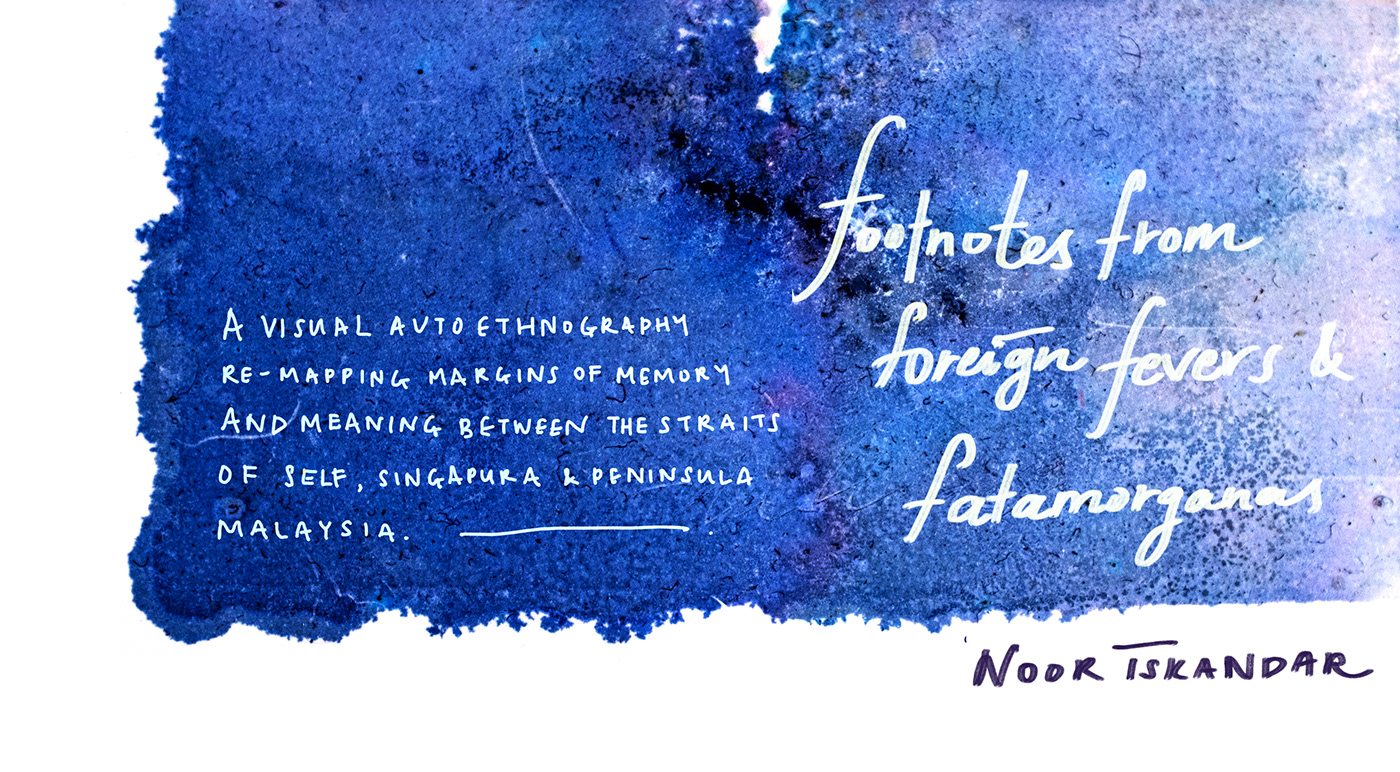
"Philosophy is really homesickness, an urge to be at home everywhere", I pondered upon this aphorism by Novalis, along with a desire to situate my eloping memories into momentary homes. These remembrances intersect two geographical and cultural situs; Singapore and Peninsular Malaysia. As the border along the Straits of Johor re-opened in April 2022 after more than two years of pandemic curtailment, the thawing of distant memories rendered spotty, unreliable vignettes. This paper is an autoethnographic undertaking that considers hybrid qualitative methodologies in an attempt to rearrange these memories and reassign derivative meanings through visual and textual narratives, whilst engaging multi-perspectives of an art practitioner, poet and sojourner. Extending from the Self, the paper renegotiates the larger tropes of losing, (visual) language and (re)imagining to distill an organically experimental landscape of remembering.
CONTEXT OF VISUAL AUTOETHNOGRAPHY - first published under the NAFA Facultry Research Series.
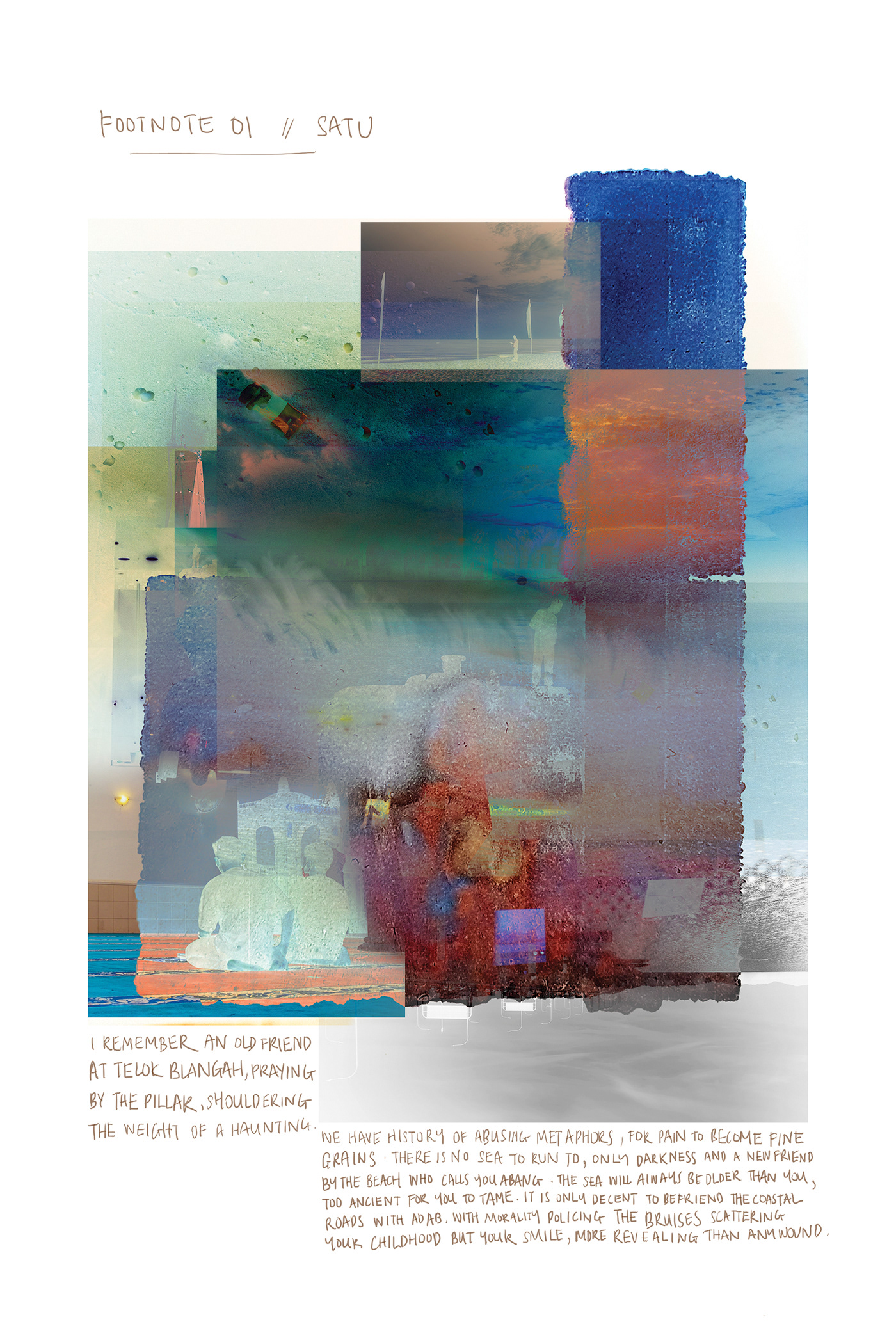
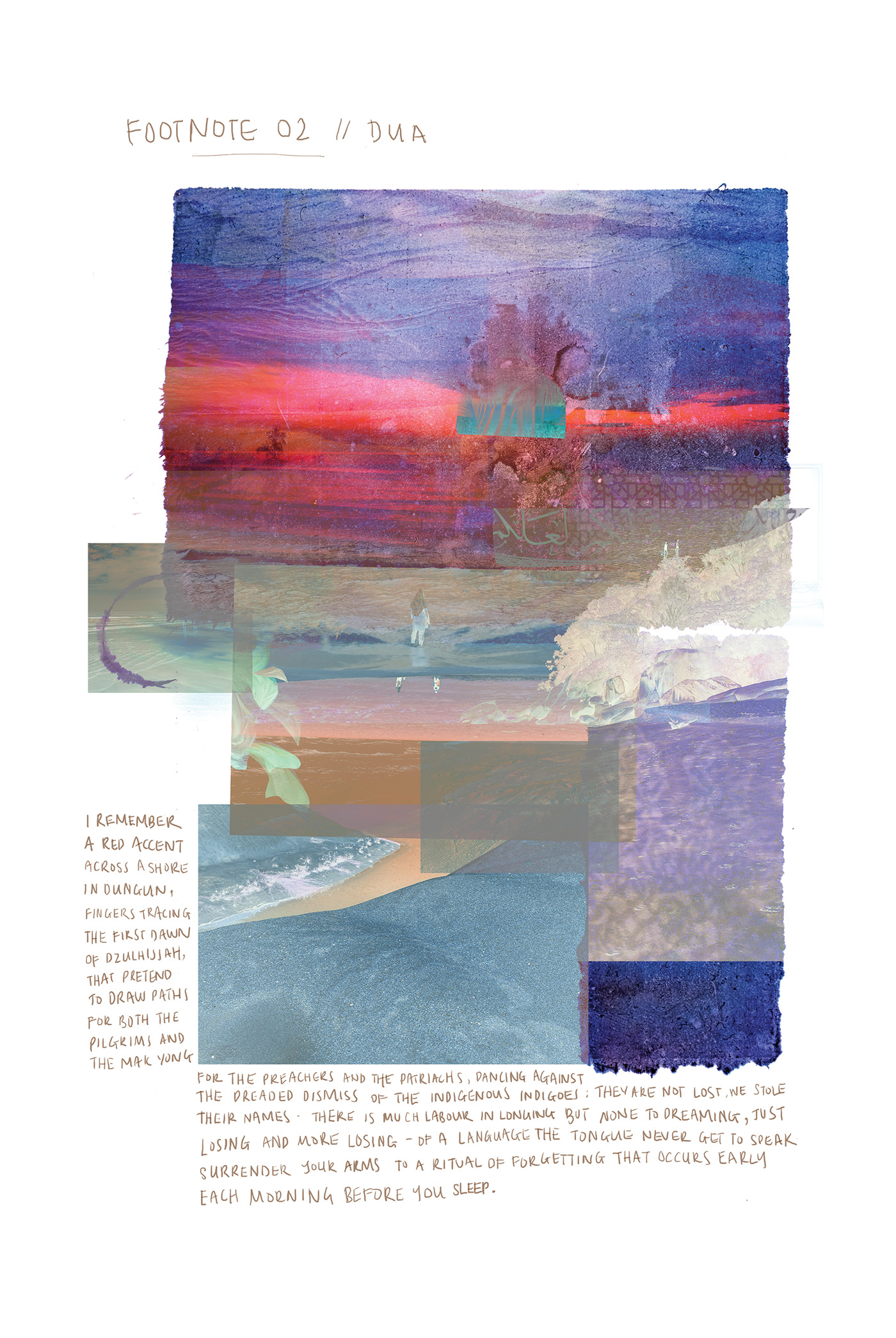
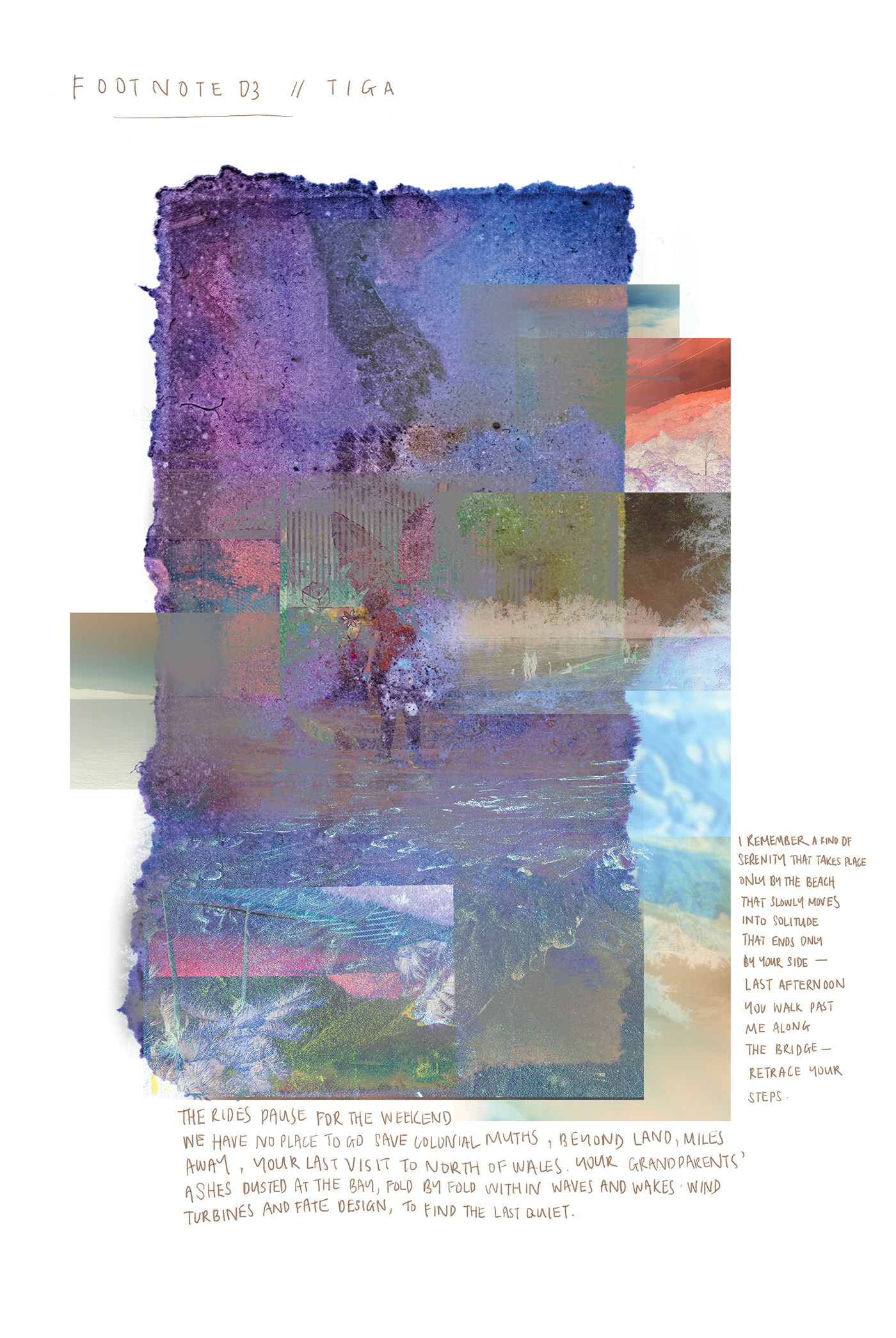
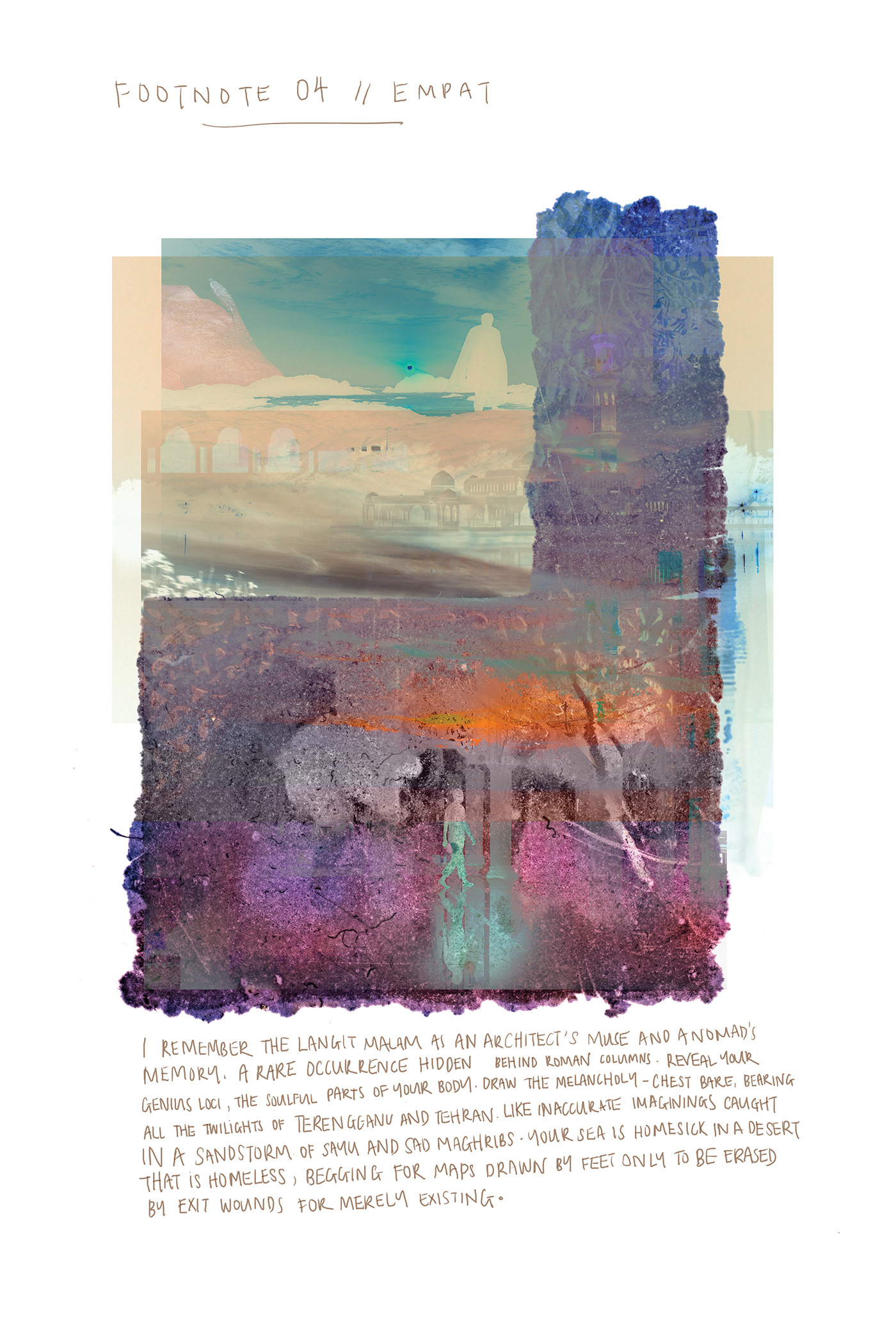
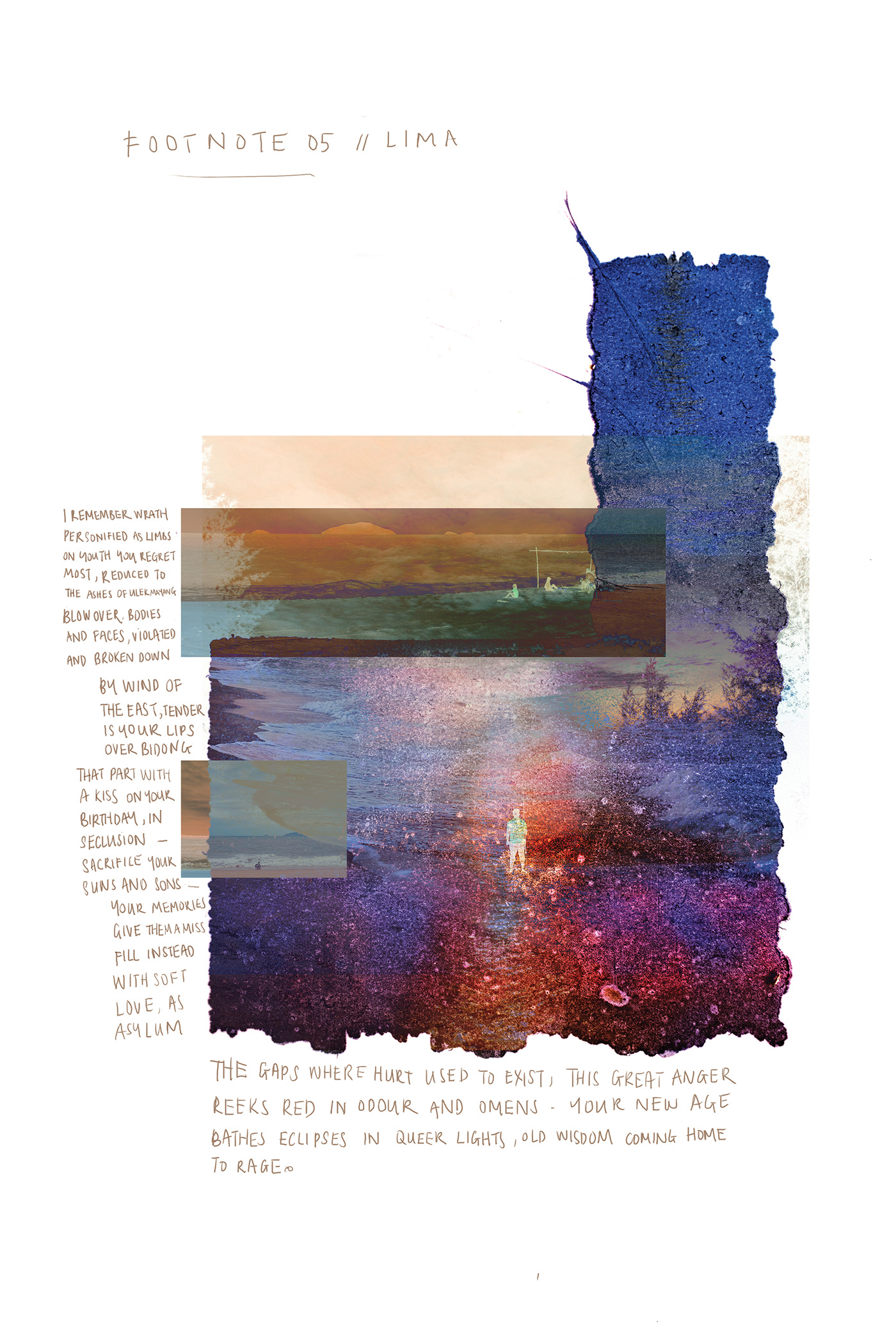
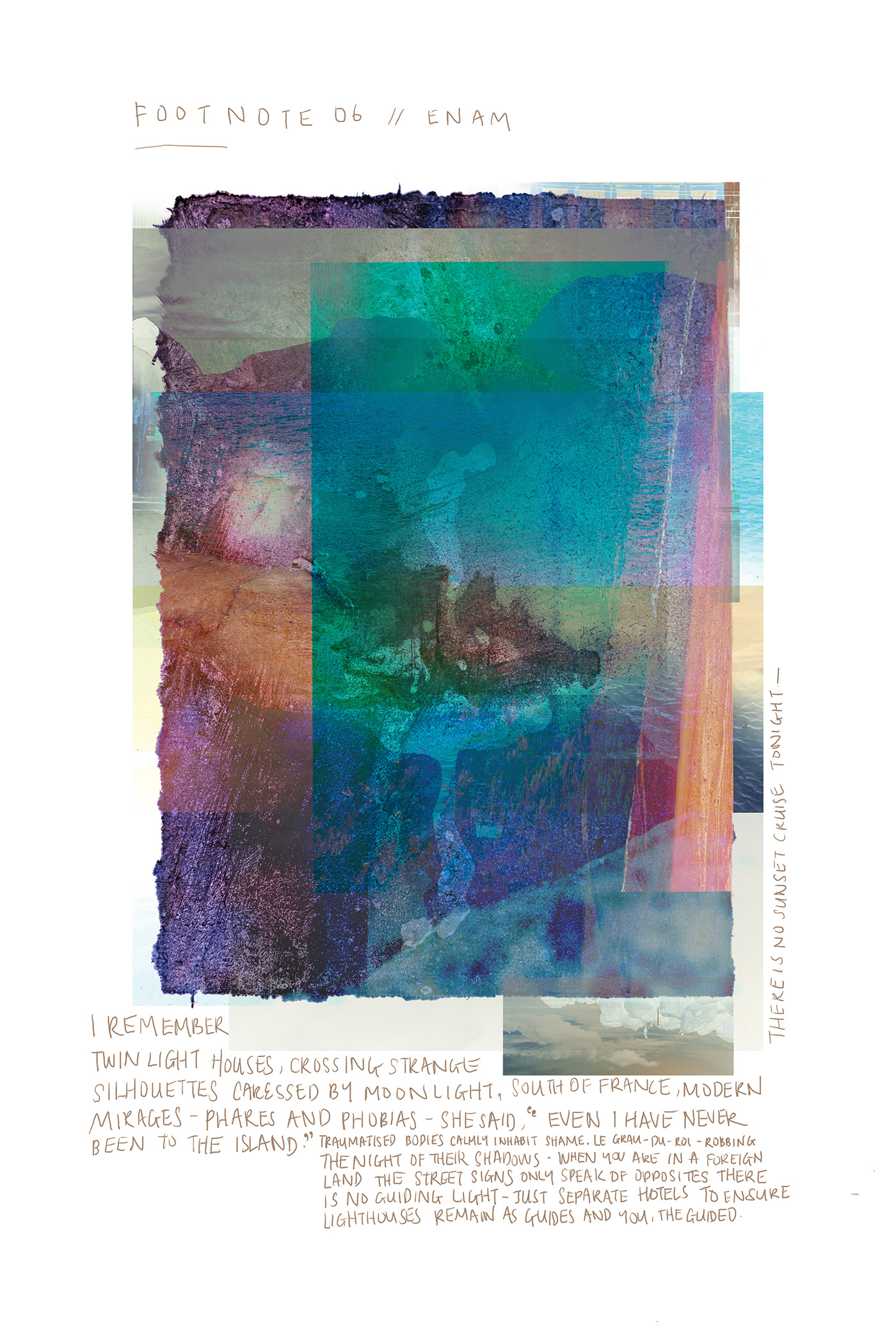
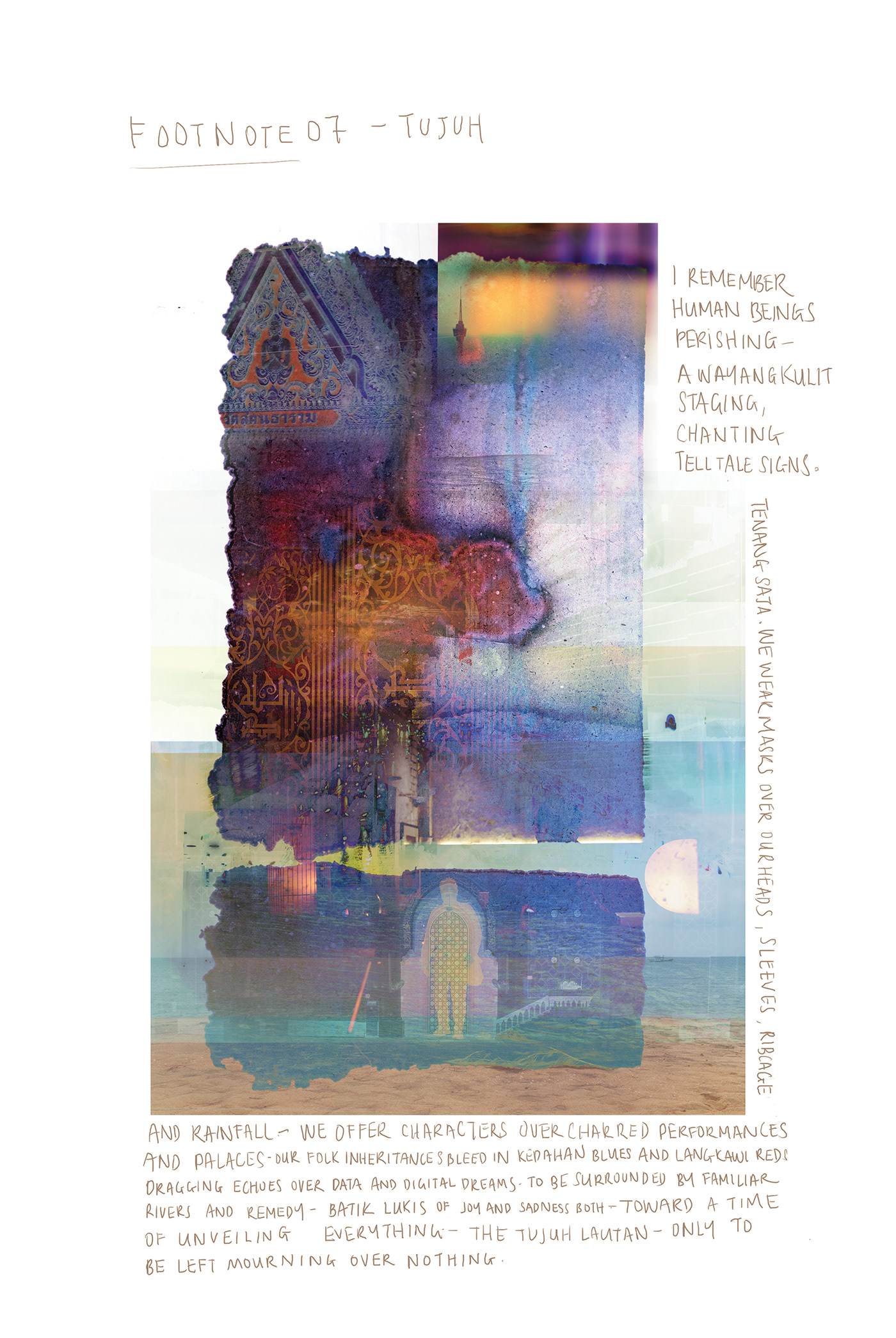
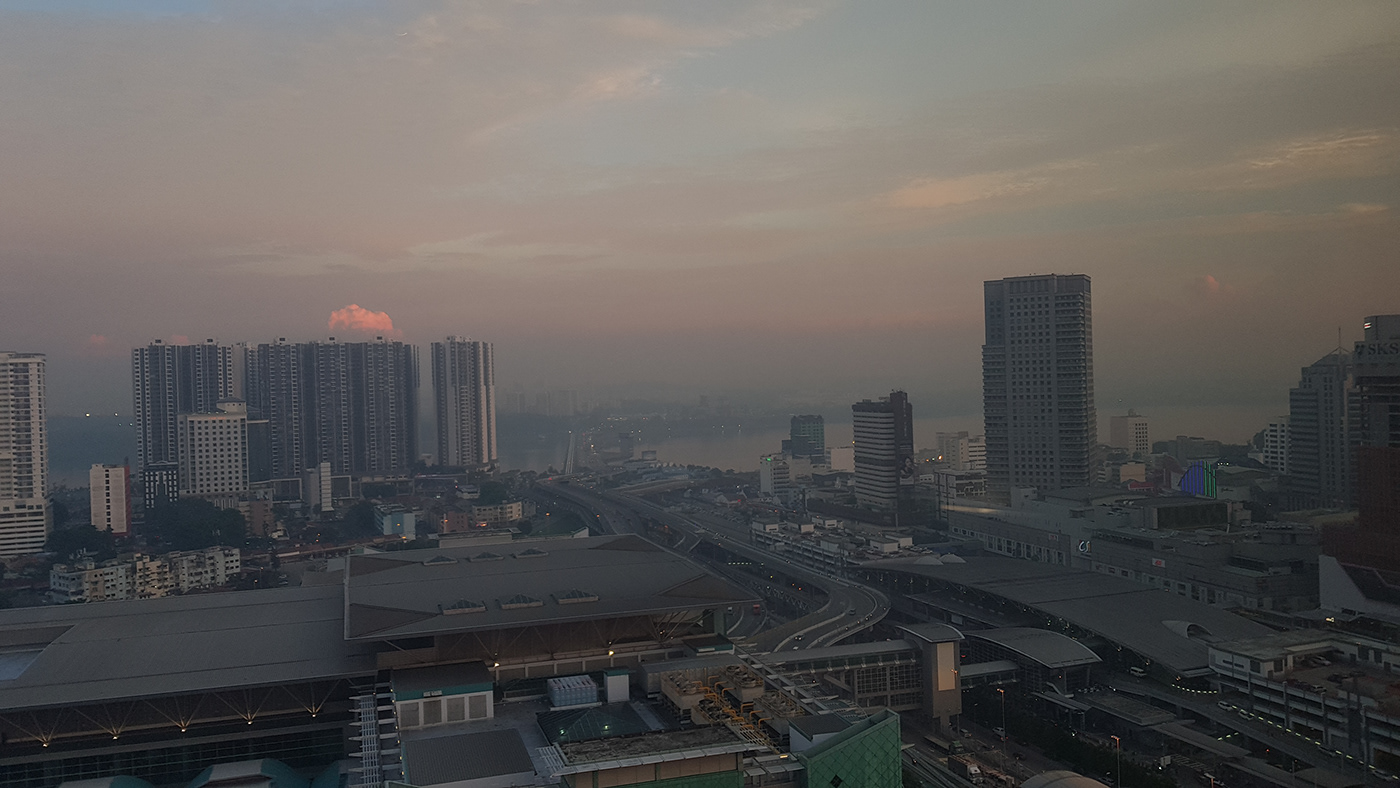
On a dusk like this, my heart skipped twice. First, at the reminder of the many sunsets we once shared; the other, at your complete absence from my sky. If I had my way, we would be collapsing, our arms- dangling, lusting for light, scrambling to pick up tar rotten by way of loneliness. Your spine is the strait between time and space. I am the body drowning.The sea is not for crossing. The border is closing on us.
Language is akin to geographical borders; demarcations both physical and abstract, amorphous yet politically charged, troublesomely sacred yet vulnerable to (re)imagination. Take the word ‘fatamorgana’- a diction I encountered within the Malay Language (Bahasa Melayu) vernacular, that translates to a mirage. Etymologically hazy, its origin presumably Italian, adding to the lexicon of traversing tongues. In adolescence, I titled my blog Fatamorgana Senja (The Mirage of Dusk), reveling in melancholic prose-poems in English and Malay. Trained in lens-based techniques, I then observed image-making rendering the same seduction whereby a photograph possesses tacit complicity between margins of memory and meaning, the unfurled, the already lost and the becoming.
I departed from layers of disorientations surrounding my lived experiences, in its relation to losing. The philosophy and praxis of the methodology employed entangled the individual and collective memory- weaving a patchwork comprising motifs of geo-history, visual theory and identity politics. Through auto narratives and practice-led approach, the research traversed three phases- foremostly by evoking my own embodied memory thereafter, situating them on sites of visual theory. I then embarked on an experiential sojourn across Malaysia scouring the edifices of the land/sea, her entities and tendencies. With these itinerant fieldnotes and reflexive interlocutions as stimulus, I finally engaged in an image-text cartographic work as a culminating tapestry, postured ala the Surrealists’ Exquisite Corpse.
This disillusionment of my nomadic body and its erasures acted as foreign fevers to be ritualized, staged as “acts of activism” as Guy Cools suggested in his book Performing Mourning: Laments in Contemporary Art. He cited that “we all share this need for our grief to be witnessed”. Coupled with Barthesian semiotics and channeling John Berger’s method of confabulations, I hope the work will inspire researchers and practitioners in Art to dabble in the potential of considered subjectivity in shaping nostalgia and present day affirmations without the burdens and guilt of mis-realities, implicating my creative lamentations as cartographic catharsis, for the individual and collective.
I) Fever Dream: Between the Straits of Johor and Familial Agitations
Much of my becoming was straddled between two nations, Singapura[1] and Malaysia, bound by memories of alternating landscapes- my grandmother’s terrace near Tampoi, distant relatives by the coast of Melaka, growing up in tandem with the Petronas KLCC Twin Towers, folk stories of Terengganu, Golok, Pendas and Endau coupled by the gravitas of Malaysian mainstream media in our household; both nebulous nostalgia and trappings of the present. Having no immediate relatives or family kampong to return to, the connection to Malaysia is even one formed quite like a fever dream, with interspersed foreignness and familiarity. Having said that, these recollections still encarve textual and visual vignettes that form many unresolved agitations within my consciousness especially as a writer and visual artist.
The porosity of memories created loopholes between conflicted terrains of belonging; toggling the margins of Singaporean-ness, Malay-ness[2], Muslim-ness etc. It is not uncommon for Malay Singaporeans to feel included in the rhetoric of the larger Malayo-Indonesian or if I may, the Nusantara (Malay Archipelago) psyche; her shared affects, customaries, religiosity, rituals and such. Thus, the dilemma of ethnic and national identity becomes a complex (at times, politically imbued) quandary to navigate. This autoethnography attempts to soften the scratchiness of these prickly conceptions, with a personal aim to attend to the multivalent parts of the Self.
For the sake of applying an anchor to a possibly tumultuous research method, I engaged with a creative stimulus; an excavation of my family photographic archives. This extended the notion of language into its consonance of the visual, where the written or verbal language will be indispensable to the ways of seeing, interpreting and narrating new materiality and mores.
[1] The non-English rendering of Singapore will be used throughout the text to emphasize the distance of language and its politics.
[2] It is valuable to note that the writer whilst biologically is of Indian-Javanese descent, has by way of generational adaptations of his ancestors to Singapore's racial model adopts the Malay conception and psyche. This in itself becomes another layer of identity dissonance.
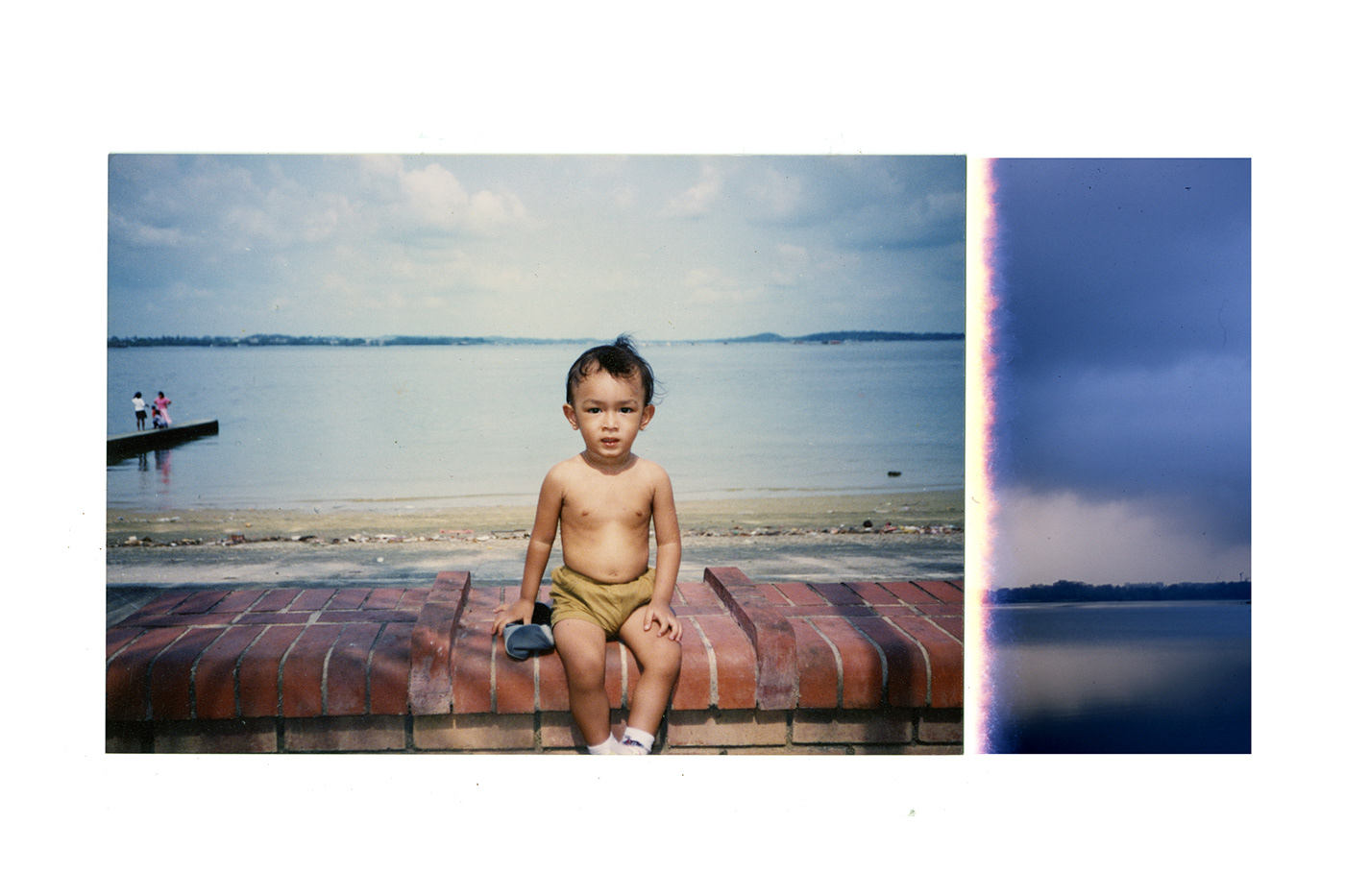
Artifact A : A digital stitch comprising two scanned archival images
Allow me to present Artifact A, of which comprises two scanned photographs from my archives, stitched digitally as one collective visual data. Acknowledging the biases involved from the editing of the photographs, to the arrangement as well as artistic means managed after, the processes hinted at the misalignments of memory work itself; that parts of remembering and forgetting tethered between the willful persuasions and the unwilled happenstance of Nature. Hal Foster wrote An Archival Impulse where he underscores the nature of all archival materials as “found yet constructed, factual yet fictive, public yet private.”[1] This impulse of being drawn “to obscure traces, ‘unfulfilled beginnings or incomplete projects’ that might offer points of departure again”, all bodes well to the very same roots autoethnography resides upon.
The right image was taken by a 35mm analog Olympus camera during an undergraduate year as a photography and digital imaging major. Quite frequently, my dad and I will course through the Yishun Dam connector for the commute to the campus in the West of Singapore. The stretch overlooks the current industrial port-district of Pasir Gudang, Johor Bahru. On one of the mornings in 2011, I asked my dad to drop me for a brief moment to compose an image across the water for an exposure exercise.
[1] Foster, H (2004) An Archival Impulse in OCTOBER 110, Fall 2004, pp. 3-22 MIT Press
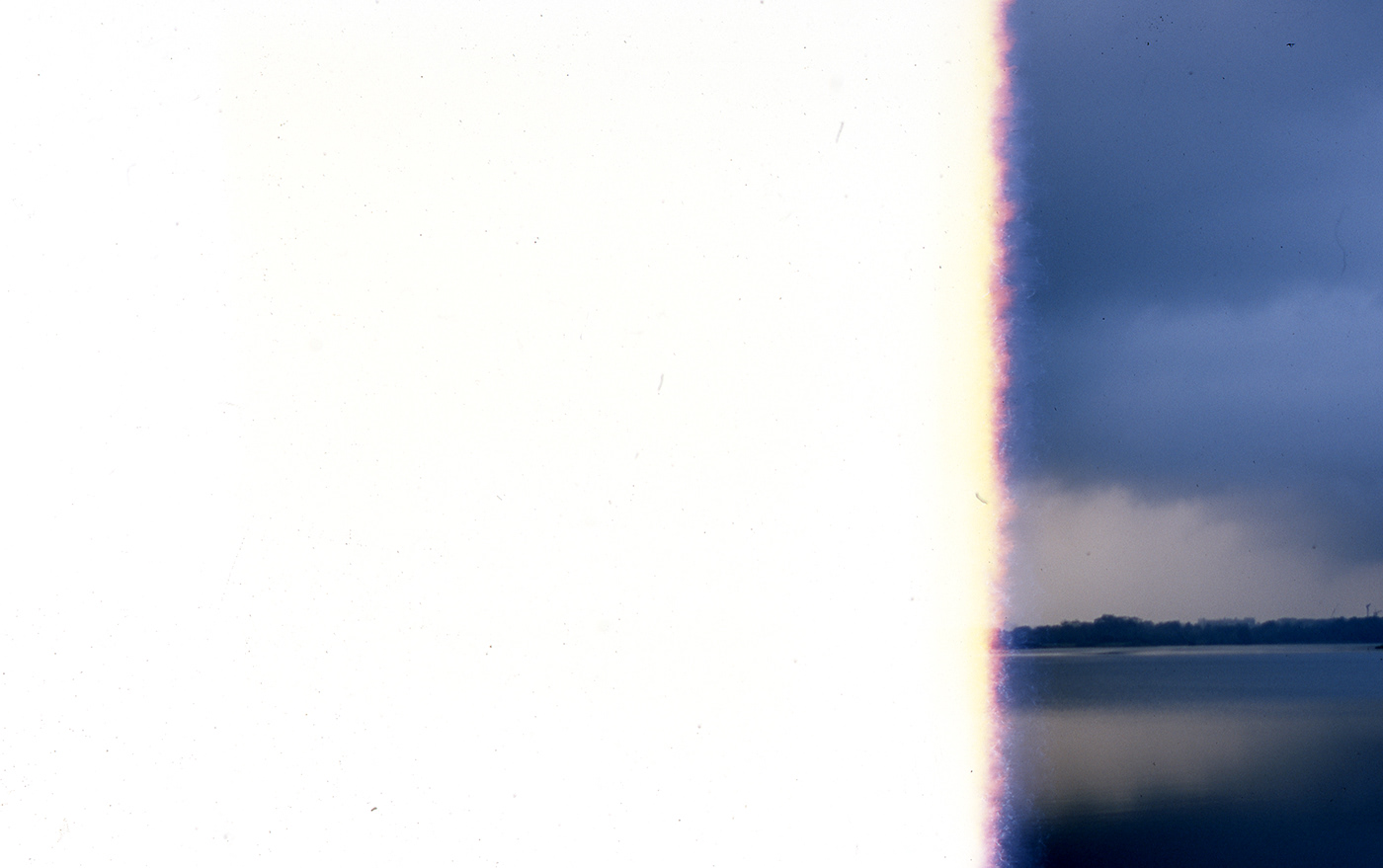
However, upon developing the film roll later that week, a noticeable erasure of the image was evident. Due to a light leak incident where straying light distressed the sensor with scattered reflections unto the negative, two-third of the frame are devoid of any exposure. What remained was a fragment of the scene, a magenta flush of reflected waterbody, tilted horizon of forests and ominous sky. The liminal space that engulfs the divide, is a band of dissipating yellow shoreline border that softly diffuses the edge of the image. The visuality instigated is dream-like, one that segues into the dance of remembering and forgetting discussed above.
The left component of Artifact A predates the former, taken by a family member when I was approximately 4 of age, close to thirty years ago. Having an extremely foggy recollection of this scene, I was informed by my parents that this was photographed along the coastal stretch of Pantai Lido (Lido Waterfront Boulevard), the southern fringe of Johor Bahru. They added that our family used to patronize a Chinese seafood stall, ‘Ah Hock’ nearby this spot. Conversely, the background at the far distance suggests Singapore’s Northwestern terrains of Sungei Buloh-Kranji. This photograph must have also been taken by an analog camera, possibly the one passed down from my grandmother, whom exposed me to this recording device in my childhood. On it, my stoic expression countered the not so innocent junctures of displacements brooding the straits. It also suggests how amorphous memory can be toying the margin of factuality and fallibility, where others also partake in our acts of remembering.
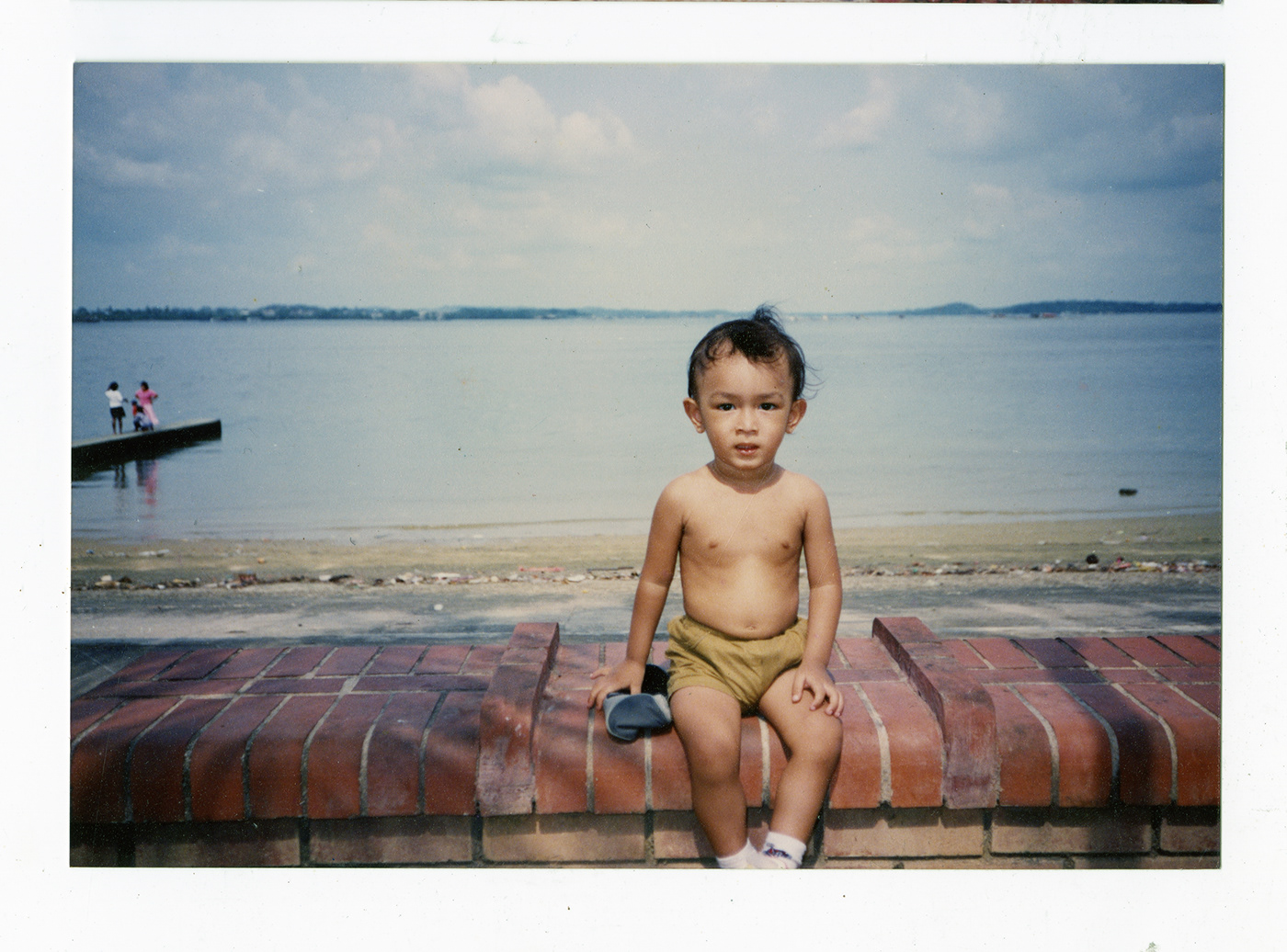
A month before my sojourn, I carried out a preliminary site visit to this spot, uncertain of its exact coordinates. I tried to locate the red bricked seawall along the shore as well as the wooden jetty extending out into the sea to no avail. While the visuals indicated in the archival photograph seems quite dissonant with the present shoreline, I found resonance in the contour of the vegetation in the horizon line farther away across the Tebrau Strait, similar to the one in Artifact A. I held close the printed photograph against the morning sun and attempted to align the horizon line, collapsing the severity of Time with the converging of Space, two quintessence of memory work, and by association, of losing.
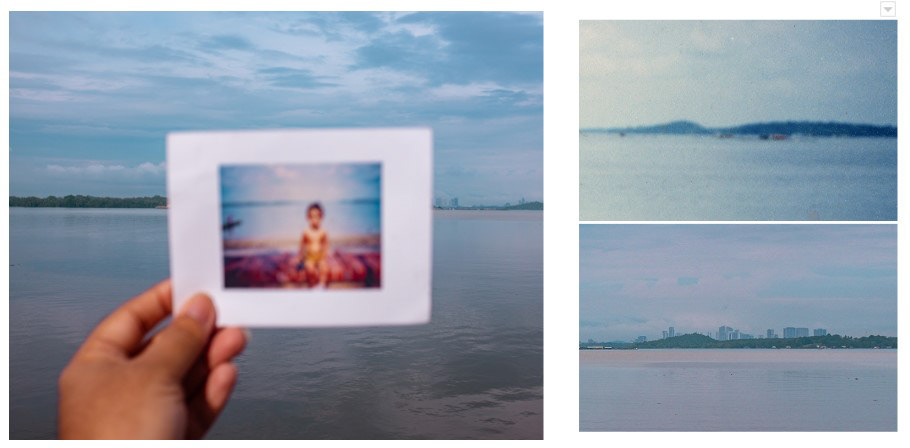
According to a study by Mohd Amirul Hussain et al., Pantai Lido underwent “aggressive” quagmire…a “de-territorialisation of cultural landscape”[1] that extends into Danga Bay with residential and commercial districts towering over the spot I stood that morning. The tropes of “dislocation, disruption and demolition” drew parallel to this traumatic tension of forgetting. Contextually, such residues hinted at larger geopolitical dimensions that fraught the two countries; its merger and separation, like former lovers that carry their historical baggage across its causeway spines burdening the sea. Within all the intersections gripping the contemporary Malay body, the term tanah air, translating to “land of water” encapsulates a mantle of the meandering ‘homeland(s), considering indigenous histories of archipelagic wayfaring labeled as “merantau”.
It is evident that for ethnic bodies and nomadic communities, the sea/water becomes an impeccable raison d'etre for resistance. This affinity was rekindled in this autoethnography as I learned the temper of the lands- in languages and languor, teasing fluid inheritances into reimagination.
[1] Hussain, M.A., Mohd Yunos, M.Y., Ismail, N.A., Mohd Ariffin, N.F., Ismail, S., & Qianda, Z. (2022). Investigating the Challenges Faced in Designing Cultural Landscape at Pantai Lido Urban Waterfront, Johor Bahru, Malaysia. GeoJournal of Tourism and Geosites, 41(2), 376–386. https://doi.org/10.30892/gtg.41206-840




